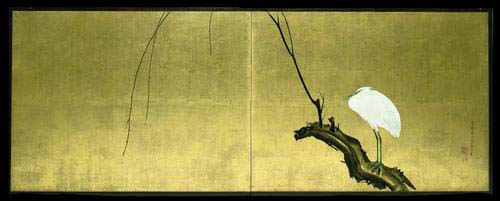Byobu Part II
dal 13/8/2001 al 16/9/2001
Segnalato da
13/8/2001
Byobu Part II
Cleveland Museum of Art, Cleveland
Painted folding screens, called byobu in Japanese, served many purposes throughout Japanese cultural history. The screen could be made of two or six vertical panels, hinged together to form a flexible "wall," generally about five feet high. Constructed of layers of paper over a light wooden lattice frame, such a hinged screen stands by itself when set upright in a zig-zag position, but it can easily be moved by collapsing it and carrying the whole to another location.

Painted folding screens, called byobu in Japanese, served many purposes throughout
Japanese cultural history. The screen could be made of two or six vertical panels, hinged
together to form a flexible "wall," generally about five feet high. Constructed of layers of paper over a light wooden lattice frame, such a hinged screen stands by itself when set upright in a zig-zag position, but it can easily be moved by collapsing it and carrying the whole to another location.
Inside a Japanese house, such screens could be adjusted to hide service areas such as a
kitchen or hallway, or to separate one space from another. In Buddhist temples or governmental
audience halls they served as important ceremonial furniture. Because of their flexibility, byöbu
could be adapted to a variety of spaces. Sometimes only two or four panels might be displayed.
Screens were occasionally used outdoors for seasonal picnics, festivities, and nature-viewing
expeditions. No matter how Japanese screens were utilized, their expansive surfaces inspired
inviting, dynamic compositions akin to Western mural painting.
The materials used to create these byobu ink and color on paper or cloth, stretched over
light wood frameworks make it impossible to display these works often because of their
susceptibility to damage from exposure to light. For the preservation of the works, therefore,
and also because CMA’s collection is so numerous, Unfolding Beauty: Japanese Screens from
the Cleveland Museum of Art will be presented in two four-week groupings Part I will be on
view from July 15 through August 12, 2001; Part II will be on view from August 14 to Sept. 16, 2001.
About the Installation
A spare and spacious installation was conceived for these paintings so the explanatory and
background information about each work typically seen in the museum's exhibitions is provided
in free brochures instead of on wall labels.
Gallery Hours
Tuesday through Sunday 10:00 - 5:00
Wednesday and Friday 10:00 - 9:00
Closed Mondays, July 4, Thanksgiving, December 25, and January 1
Galleries close early at 4:00 on December 24 and 31



